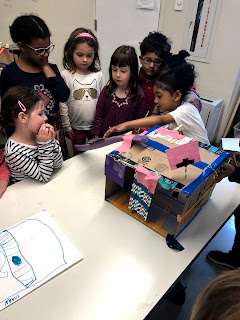When I am creating lessons and projects for learners the focus is on making connections with literature and research skills, developing a collaborative mindset, and building and making skills. For kindergarteners, there are so many amazing picture books to work with that inspire wonderful building projects. Some of my favorite books to use are by author Corey Rosen Schwartz. Her stories are humorous and engaging for students and the topics she presents in her stories make great connections to collaboration and design projects. “What about Moose?” is a great book that brings together literature, collaboration and making.
I started the project with reading the book. Students talked about the beginning, middle and end of the story, the setting, the problem and the solution. We documented all of their notes on the board. Then we talked about the characteristics and behavior of the main character Moose. Students shared words to describe Moose’s behavior and cited evidence in the book. Students then focused on the question “Was Moose a good teammate?” Students shared their thoughts and again found evidence in the book to support their ideas. Kindergarteners unanimously agreed that Moose was not a good team member. Moose was bossy, he didn’t listen to his friends, he did not help with the hard work and he criticized his friend’s work. Learners then shared what some characteristics of a good team member. They talked about sharing ideas, helping each other, listening and everyone working on a project together. Through this work learners were “Actively contributing to group discussions” (Learner III.D.1) and “developing new understandings through engagement in a learning group” (Learner III.A.2). Kindergarteners were making connections with other students, sharing their ideas, and making the connections with the story and the characters.
The next step was the building challenge inspired by the story. In the book Moose is not listening to his friends and is too busy bossing everyone around and he ends up stuck inside the treehouse. His friends come together and build a slide to get Moose out of the house. Kindergarteners challenge was to build a prototype of a house that Moose could get in and out. They would be working in groups, thinking about how they could be good team members. Kindergarteners could use any of the materials in our makerspace including cardboard, foam, bubble wrap, pool noodles, etc. Each group was given a cardboard Moose. They had to show that their cardboard Moose could fit in and out of their prototype treehouse.
Teams worked together to plan their design. Students talked to each other, explored different materials and then started building. They shared ideas, designed and then redesigned. Kindergarteners shared responsibilities and building jobs to complete their treehouse designs. Throughout the design and building process, learners “solicited and responded to feedback from others” (Learner III.C.1) as they worked with their teams to create their treehouses. They were also “actively contributing to group discussions” (Learner III.D.1), kindergarteners presented their ideas, planning, building and then redesigning together. As students presented their final projects with the whole class, kindergarteners shared the different contributions of each team member to the final product. They talked about team members coming up with the idea to use a certain material, or whose idea it was to attach a rope ladder. Through this project, learners were “recognizing learning as a social responsibility” (Learner III.D.2). Kindergarteners were developing the understanding that by working together, listening and building with others they were able to solve a problem and build some really cool treehouses for Moose.





